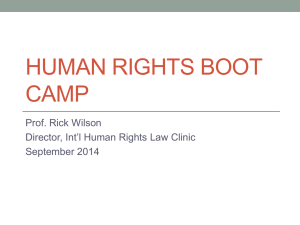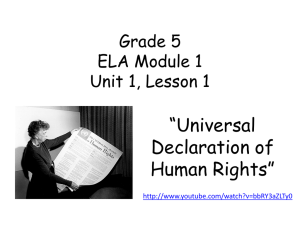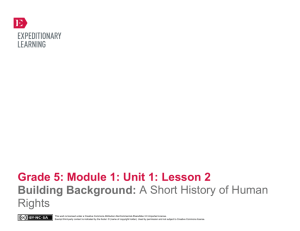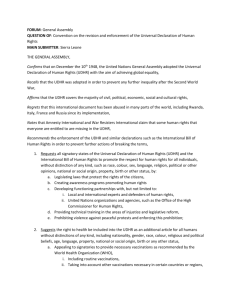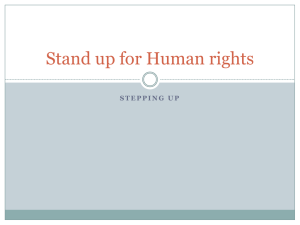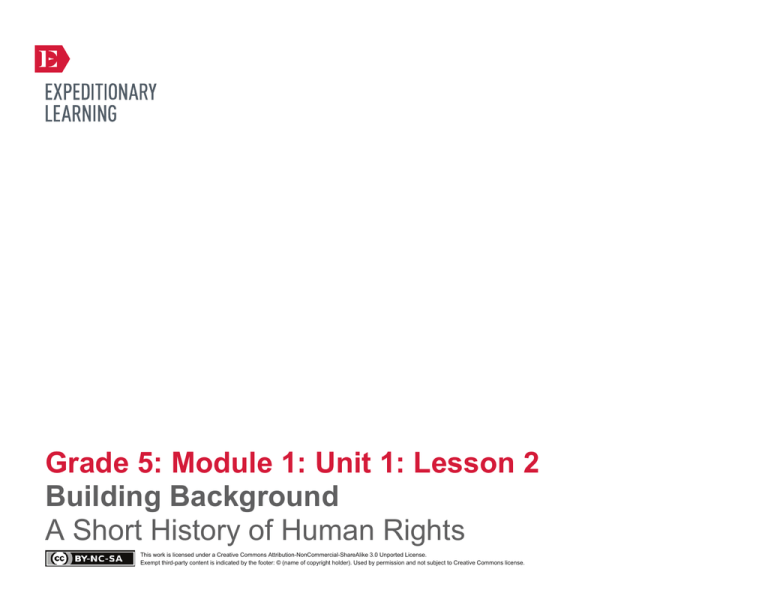
Grade 5: Module 1: Unit 1: Lesson 2
Building Background
A Short History of Human Rights
This work is licensed under a Creative Commons Attribution-NonCommercial-ShareAlike 3.0 Unported License.
Exempt third-party content is indicated by the footer: © (name of copyright holder). Used by permission and not subject to Creative Commons license.
GRADE 5: MODULE 1: UNIT 1: LESSON 2
Building Background:
A Short History of Human Rights
Long-Term Targets Addressed (Based on NYSP12 ELA CCLS)
I can effectively engage in a discussion with my peers. (SL.5.1)
I can determine the main idea(s) of an informational text based on key details. (RI.5.2)
I can explain important connections between people, events, or ideas in an informational text accurately. (RI.5.3)
Supporting Learning Targets
Ongoing Assessment
• I can use text and visual images to help me understand human rights.
• Group anchor charts
• I can follow our class norms when I participate in a conversation.
• Annotated texts
• I can explain some of the main events that relate to the history of the Universal Declaration of Human
Rights (UDHR) by making a human timeline with my peers.
• Student journals
• Exit tickets
Agenda
Teaching Notes
1. Opening
A. Engaging the Reader: Revisiting the Meaning of Human Rights (5
minutes)
2. Work Time
A. Viewing and Discussing UNICEF Video “For Every Child” (10
minutes)
B.
A Short History of Human Rights: Key Events (15 minutes)
C.
Constructing a Human Timeline (20 minutes)
3. Closing and Assessment
A. Routine Writing: What Did the Authors of the UDHR Believe? (10
minutes)
4. Homework
• In advance: Display the learning targets on the board, chart paper, or a document
camera. Cut one copy of the Short History of Human Rights handout into eight
sentence strips; students will work in small groups during Part B of Work Time (one
strip per small group).
Copyright © 2013 by Expeditionary Learning, New York, NY. All Rights Reserved.
• Review: Write-Pair-Share and Gallery Walk protocols (see Appendix 1).
• Post: Learning targets.
NYS Common Core ELA Curriculum • G5:M1:U1:L2 • July 2013 •
1
GRADE 5: MODULE 1: UNIT 1: LESSON 2
Building Background:
A Short History of Human Rights
Lesson Vocabulary
Materials
visual, relate, timeline, chronological,
excluded, conflict, constitution,
throughout
• Universal Declaration of Human Rights (from Lesson 1)
• Close Readers Do These Things anchor chart (begun in Lesson 1)
• A Short History of the UDHR: Complete Version (one per student)
• A Short History of the UDHR Sentence Strips (one copy cut into eight strips)
• Computer and projector (to show video)
• UNICEF video “For Every Child”
(2010; http://www.youtube.com/watch?v=Mmy9MpwyKnQ&noredirect=1)
• Scrap paper
• 2 pieces of paper; one titled “A Long Time Ago,” and the other titled “2012” (to post during Work Time)
• Chart paper
• Markers
• What are Human Rights anchor charts (from Lesson 1; created by students in small groups)
Copyright © 2013 by Expeditionary Learning, New York, NY. All Rights Reserved.
NYS Common Core ELA Curriculum • G5:M1:U1:L2 • July 2013 •
2
GRADE 5: MODULE 1: UNIT 1: LESSON 2
Building Background:
A Short History of Human Rights
Opening
Meeting Students’ Needs
A. Engaging the Reader: Revisiting the Meaning of Human Rights (5 minutes)
• Say to students:
• Provide nonlinguistic symbols
(e.g., a question mark for
question, a pen for record, a
magnifying glass for
clarifying) to assist ELLs and
other struggling readers in
making connections with
vocabulary. These symbols can
be used in directions and
learning targets throughout
the year.
*
“Today we are going to continue our discussion of human rights that we started yesterday.”
• Read the learning target aloud:
*
“I can follow our class norms when I participate in a conversation.”
• Ask students to name something that helps conversations go well. Encourage them to pay attention to that as they work together
today.
• Read aloud the next two learning targets. Focus on the first target, and specifically the word visual. Ask:
*
“Does the word visual remind you of any other word you know?”
• If students don’t bring up “vision,” offer it. Ask:
*
“Do you think vision and visual are similar in meaning? If so, what’s a visual image?”
• Focus students on the third target. Have a similar conversation about the words relate and relationship.
• Ask students to revisit the charts they wrote at the end of Lesson 1. Remind them that their understanding of this important
concept will continue to grow the more they read, talk, and write about it over the course of the next several weeks.
• Ask them to briefly consider:
*
• If groups are having trouble
taking turns listening to each
other, they can be provided a
“sharing object” to pass that
indicates whose turn it is, or
they can be timed to give all
students an equal opportunity.
“What additional human rights might the authors of the UDHR want all people to have?”
• Invite them to talk with a partner, but do not discuss it as a class at this point.
Copyright © 2013 by Expeditionary Learning, New York, NY. All Rights Reserved.
NYS Common Core ELA Curriculum • G5:M1:U1:L2 • July 2013 •
3
GRADE 5: MODULE 1: UNIT 1: LESSON 2
Building Background:
A Short History of Human Rights
Work Time
Meeting Students’ Needs
A. Viewing and Discussing UNICEF Video “For Every Child” (10 minutes)
• Provide ELLs bilingual word-for-word
translation dictionaries or online
translation sources such as Google
Translate to assist with comprehension.
ELLs should be familiar with how to use
glossaries or dictionaries. These are an
accommodation provided to ELLs on NY
State assessments.
• For this portion of the lesson, students will need a piece of scrap paper and something to write with. They should be
seated in eight small, heterogeneous groups.
• Ask students to listen as you read the first sentence of the UDHR aloud: “All humans are born free in dignity and
rights.”
• Tell them that today, they will keep thinking about what this sentence means and also learn more about the history of
the UDHR.
• Tell students that they will now watch a 4-minute video made by UNICEF. Ask if anyone is familiar with this
organization. If not, tell students briefly that UNICEF was created after World War II by the United Nations to take care
of children who were sick or hungry. Today they will learn more about the United Nations (UN).
• Set purpose for watching the video. Remind students that yesterday, they tried to visualize what it might look like for
Article 1 to be true for all human beings. Ask students to pay attention to the images, thinking about one specific image
that they think really conveys the meaning of Article 1 that the authors of the UDHR intended.
• When playing videos, use the English
subtitles if available. Providing a visual
can assist ELLs and other struggling
learners in understanding the content of
the video.
• Point out that there are few words on this video, and they go by quickly. For the purpose of this activity, students should
focus on the images and how they relate to Article 1 of the UDHR or the bigger idea of human rights.
• Play the 4-minute UNICEF video “For Every Child” (2010).
• When the video is finished, give students a minute to think silently about what image they thought represented the
meaning of Article 1. Invite students to write their response, then share with a partner.
Copyright © 2013 by Expeditionary Learning, New York, NY. All Rights Reserved.
NYS Common Core ELA Curriculum • G5:M1:U1:L2 • July 2013 •
4
GRADE 5: MODULE 1: UNIT 1: LESSON 2
Building Background:
A Short History of Human Rights
Work Time
Meeting Students’ Needs
B. A Short History of Human Rights: Key Events (15 minutes)
• Consider partnering an ELL with a
student who speaks the same home
language when discussion of
complex content is required. This
can let students have more
meaningful discussions and clarify
points in their home language.
• Tell students that they probably have many questions about the UDHR. Model a question if necessary. Ask students to
Think-Pair-Share about some of their questions. Invite a few to share out. Chart their questions but do not give answers at
this point. The goal is to build curiosity.
• Listen for a question about the history of the UDHR and tell students that this is what they will focus on today:
*
“Where did this document come from?”
*
“Why was it written?”
*
“Who wrote it?”
*
“When?”
• Revisit the third learning target:
*
“I can explain some of the main events that relate to the history of the UDHR by making a human timeline with my
peers.”
• Ask students to write down their understanding of the word timeline and then share their ideas with a partner. Define as
necessary: “a visual to show the order in which things happened, which is also called chronological order.” To illustrate this
concept, draw an image of a timeline on the board and give students an accessible example (such as a timeline about their
lives: birth, starting school, to fifth grade).
• Tell students that when readers study a historical document, it is often important to understand when it was written and
what events led up to it. That is what they will do today with the UDHR.
• Tell students that they will now work in their small group on one short piece of text. Their job will be to help each other
understand each piece of text and figure out as a class how they all go together to help us understand the history of the
UDHR.
• Tell students that in their small groups, they should do things that close readers do. Reorient them to the Close Readers
Do These Things anchor chart (from Lesson 1):
1.
Read the text slowly at least twice.
2.
Circle words you aren’t sure of and try to figure them out.
3.
Reread, annotate, and underline key vocabulary.
4.
Talk with each other about what you think it means.
5.
Read again to summarize or answer specific questions.
Copyright © 2013 by Expeditionary Learning, New York, NY. All Rights Reserved.
NYS Common Core ELA Curriculum • G5:M1:U1:L2 • July 2013 •
5
GRADE 5: MODULE 1: UNIT 1: LESSON 2
Building Background:
A Short History of Human Rights
Work Time (continued)
Meeting Students’ Needs
• Give each group one of the “A Short History of the UDHR” sentence strips and ask them to read closely with their
group and try to put the words on their strip in their own words. Each group should have their own words written down on
scrap paper so they can share later.
• Ask them to dive in. Give students 5 to 10 minutes to work with their group, being sure they are working to try to put the
sections into their own words. As groups work, circulate to listen in and support as needed. As they are working, post two
pieces of paper on opposite sides of the room, one labeled “A Long Time Ago” and the other labeled “2012.”
Copyright © 2013 by Expeditionary Learning, New York, NY. All Rights Reserved.
NYS Common Core ELA Curriculum • G5:M1:U1:L2 • July 2013 •
6
GRADE 5: MODULE 1: UNIT 1: LESSON 2
Building Background:
A Short History of Human Rights
Work Time
Meeting Students’ Needs
C. Constructing a Human Timeline (20 minutes)
• If necessary, have students first
practice making a human timeline
based on an easy topic: their
birthdays. Ask students to get in
order based on their birthdays:
January birthdays go to one side of
the room, and then students get in
order next to them: February,
March, April, etc.
• When groups are finished, ask all students to stand. They should stay with their peers who read the same sentence strip.
• Tell students that they are now going to create a human timeline to show the order of events that led up to the UDHR being
written, and some events that happened after it was written.
• Direct students’ attention to the two pieces of paper, “A Long Time Ago” and “2012.” Tell them that their job will be to figure
out where to stand based on the information they read.
• Invite one group to model:
*
“Who read information about events that happened a long time ago?”
• Listen for the group that read about the Golden Rule or the U.S. Bill of Rights to volunteer. Ask them to read their sentence
out loud to the class. Then ask them to bring their sentence strips and the version they wrote in their own words with them
and go stand by the paper that says “A Long Time Ago.”
• Check for understanding; be sure students are clear that they need to locate themselves physically into eight clumps based
on the sequence of the eight events the class has information about. Tell students to proceed and remind them to be
respectful as they move about the classroom, keeping their voices down and their bodies to themselves. But they will need to
talk with each other to try to figure out the right order of events.
• Allow 5 minutes for the groups to get into the correct spots on the timeline.
• Distribute “A Short History of the UDHR” (the complete version, with all eight sections) to each student. Starting with
the group that had the passage about the Golden Rule, invite someone from each group to read their sentence strip aloud
and then say the version they wrote in their own words. Encourage the class to listen and follow along on the handout.
• Let students know that in a minute, they will have time to talk in pairs about a few of these events. They are not expected to
remember them all right now.
• After each group has read, ask students to return to their seats. Ask:
*
“What words helped you figure out the order of events?”
• Listen for students to point out key academic vocabulary, specifically transitional phrases such as throughout, in, during,
and after.
• Ask students to underline these words in their text. Emphasize how important it is for readers to pay attention to these
signals, particularly when reading about history.
Copyright © 2013 by Expeditionary Learning, New York, NY. All Rights Reserved.
NYS Common Core ELA Curriculum • G5:M1:U1:L2 • July 2013 •
7
GRADE 5: MODULE 1: UNIT 1: LESSON 2
Building Background:
A Short History of Human Rights
Closing and Assessment
Meeting Students’ Needs
A. Routine Writing: What Did the Authors of the UDHR Believe? (10 minutes)
• Consider providing sentence stems or starters or allowing
students to draw their observations, ideas, or notes when
appropriate. This allows ELLs to participate in a
meaningful way.
• Post the following prompt:
* “The authors of the Universal Declaration of Human Rights wanted to be sure that some events
never happened again. Which events? Why? Use specific details from the text in your answer.”
• Allow students about 5 minutes to write.
• Then ask them to share their writing with a neighbor.
Homework
Meeting Students’ Needs
• Reread “A Short History of the UDHR.” Make some notes in the margins about what you now
understand and any questions you still have. Tell someone at home about the history of the UDHR.
See if you can figure out why people in New York feel a special connection to the UDHR and the
United Nations. Bring your copy of “A Short History of the UDHR” to class tomorrow.
Copyright © 2013 by Expeditionary Learning, New York, NY. All Rights Reserved.
NYS Common Core ELA Curriculum • G5:M1:U1:L2 • July 2013 •
8
Grade 5: Module 1: Unit 1: Lesson 2
Supporting Materials
This work is licensed under a Creative Commons Attribution-NonCommercial-ShareAlike 3.0 Unported License.
Exempt third-party content is indicated by the footer: © (name of copyright holder). Used by permission and not subject to Creative Commons license.
GRADE 5: MODULE 1: UNIT 1: LESSON 2
A Short History of the UDHR Sentence Strips
(Instructions to Teacher: Cut this page into eight strips, one for each short excerpt. Give one strip to each small group during
Work Time, Part B. Later, give students each a full copy of this page.)
Throughout history, most societies have had traditions such as the golden rule. This means “Do unto others as you would have
them do unto you.”
-------------------------------------------------------------------------------------The U.S. Bill of Rights came into effect in 1791 but excluded (did not apply to) women, people of color, and members of certain
social, religious, economic, and political groups.
-------------------------------------------------------------------------------------In 1919, the International Labor Organization (ILO) was formed to protect workers to be sure they stayed healthy and safe. But
this organization didn’t last.
-------------------------------------------------------------------------------------During World War II (in the 1930s and 1940s), millions of people were killed by the Nazis. These included Jews, gypsies, and
people with disabilities.
-------------------------------------------------------------------------------------President Franklin Delano Roosevelt gave a speech in 1941 about his vision, or dream, for the world. He said that everyone
should have four freedoms: freedom of speech, freedom of religion, freedom from want (being hungry), and freedom from fear.
-------------------------------------------------------------------------------------In 1945, after World War II, governments decided to start the United Nations. The goal of the United Nations (UN) was to foster
peace and stop conflict, or fighting between countries, around the world.
-------------------------------------------------------------------------------------In 1948, the Universal Declaration of Human Rights was written by people belonging to the United Nations. Fifty-six nations
that belonged to the United Nations agreed to follow the ideas in this document.
-------------------------------------------------------------------------------------Today, more than 185 nations around the world have taken the ideas from the UDHR and put them in their own constitutions.
(Constitutions are the rules and laws of a country.)
Written by Expeditionary Learning for instructional purposes (2012). Adapted from Web site: Human Rights Here and Now, edited by Nancy Flowers
(University of Minnesota Human Rights Resource Center); web content was originally adapted from David Shiman, Teaching Human Rights (Denver:
Center for Teaching International Relations Publications, University of Denver, 1993): 6–7; ISBN-13: 978-0-9438-0479-8.
www1.umn.edu/humanrts/edumat/hreduseries/hereandnow/Part-1/short-history.htm (last accessed August 6, 2012).
1
Copyright © 2013 by Expeditionary Learning, New York, NY. All Rights Reserved.
NYS Common Core ELA Curriculum • G5:M1:U1:L2 • July 2013 •
10
GRADE 5: MODULE 1: UNIT 1: LESSON 2
A Short History of the UDHR:
Complete Version
Throughout history, most societies have had traditions such as the Golden Rule. This means “Do unto others as you would have
them do unto you.”
The U.S. Bill of Rights came into effect in 1791 but excluded (did not apply to) women, people of color, and members of certain
social, religious, economic, and political groups.
In 1919, the International Labor Organization (ILO) was formed to protect workers to be sure they stayed healthy and safe. But
this organization didn’t last.
During World War II (in the 1930s and 1940s), millions of people were killed by the Nazis. These people included Jews, gypsies,
and people with disabilities.
President Franklin Delano Roosevelt gave a speech in 1941 about his vision, or dream, for the world. He said that everyone
should have four freedoms: freedom of speech, freedom of religion, freedom from want (being hungry), and freedom from fear.
In 1945, after World War II, governments decided to start the United Nations. The goal of the United Nations (UN) was to foster
peace and stop conflict, or fighting between countries, around the world.
In 1948, the Universal Declaration of Human Rights was written by people belonging to the United Nations. Fifty-six nations
that belonged to the United Nations agreed to follow the ideas in this document.
Today, more than 185 nations around the world have taken the ideas from the UDHR and put them in their own constitutions.
(Constitutions are the rules and laws of a country.)
Copyright © 2013 by Expeditionary Learning, New York, NY. All Rights Reserved.
NYS Common Core ELA Curriculum • G5:M1:U1:L2 • July 2013 •
11

